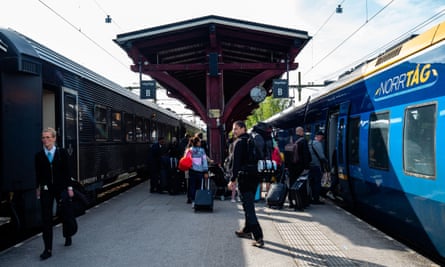Religious purists probably assert that a pilgrimage requires walking rather than taking a train. I wasn’t inclined to spend three weeks walking to Trondheim. So I decided to give the train a shot, showing up one morning at Sundsvall railway station in Sweden for a solo three-day pilgrimage by rail.
The railway from Sundsvall to Trondheim casts a 287 miles (463km) thread across central Scandinavia, for long stretches paralleling the pilgrim trail known as St Olavsleden (St Olav’s Way). Whether by train or on foot, this is a gorgeous transect through a deeply rural region. The route extends from the Swedish shore of the Gulf of Bothnia to Norway’s Trondheim Fjord, where St Olav’s Way ends at Trondheim’s Nidaros Cathedral.
King Olav (AKA Olav Haraldsson) set out from Sweden’s east coast for Trondheim in early summer 1030, but sadly never made it. The story goes that his expeditionary force was waylaid, and Olav was fatally injured by the blow of an axe in the Battle of Stiklestad. The king’s body was interred in Trondheim and he was promptly acclaimed as a martyr and a saint. Work started on the great cathedral that today is both a shrine to Olav and an icon of Norwegian national identity.
Forests and fermentation
Rain falls relentlessly as the regional train from Sundsvall runs up the Ljungan Valley, the hillsides tilting sharper as we head inland. At Stöde, there’s a misty view of the striking white church that overlooks the lake. Two hours into the journey, I decide to appease the weather gods by stopping off for a couple of hours at Pilgrimstad, a community that once relied on logging but now plays the pilgrim card to good effect. I take the waters at the holy well, then repair to the nearby microbrewery to sample Mystic Pilgrim. The waiter assures me that this ale is just as holy as the water from the well and comes with “a clear aroma of English malt with hints of herbs and honey”.

The gods are not pleased and the rain falls even more heavily as I trudge back to the station for the journey to the lakeshore town of Östersund for a first overnight stop. Östersund is a major railway junction, and the jumping-off point for the seasonal 14-hour once-daily rail journey to Gällivare, which is way up north beyond the Arctic Circle. For those with an appetite for endless forests, this route operates in 2023 from 19 June to 26 August.
Östersund is instantly likable, a lakeshore haven with a dash of cosmopolitan style in the wilderness. I am rewarded with watery evening sunshine and take a boat trip on a restored 19th-century steamer called MS Thomée. There is chilled white wine and shrimps galore as we cruise round the island of Frösön, which has always been an important way station on St Olav’s Way.

A royal border
The next day I am back at Östersund station for the train up to Storlien. As on the previous day, the train is very modern, showcasing Norrtåg’s striking blue and yellow branding, with a smart bistro area for self-service snacks and drinks. We glide west through ever more forbidding landscapes, making tracks for the border with Norway.
I am uncertain whether to break my journey, but the helpful train manager suggests that Mörsil might be a good option. “You’ll find the best cakes in Sweden at Sundings konditori,” she says. Mörsil is a regular stopping-off point on St Olav’s Way so I pause for two hours and explore this small community in the hills which, with the coming of the railway in 1882, developed into a health resort.
After a sweet diversion at Sundings, I am back on the train heading for an overnight stop at Storlien. Alighting in the drizzle, I wonder if I have made a serious mistake. It seems uncompromisingly forlorn, but the hotel on the station platform, Le Ski Lodge & Steak House, is welcoming. A room with a view of empty railway tracks, the patter of rain on a tin roof, a log fire burning in the bar that is large enough to accommodate the entire population of Storlien.
after newsletter promotion
Storlien cuts a dash in Swedish media as the preferred Easter getaway for the Swedish royal family. “Sometimes they even drop into the hotel here,” says the waiter in the restaurant. That royal connection apart, Storlien is the beneficiary of price differences across the Swedish-Norwegian border, making this border community a favoured target for shoppers from Trondheim.
To Hell and beyond
Next morning I board the red Norwegian train that twice daily runs down from Storlien to Trondheim. It is still raining and I am the only passenger on board. We slip down from the hills and within an hour catch a first glimpse of the upper reaches of Trondheim Fjord. Barren moorland has been replaced by green pasture and red wooden farmhouses. I am very tempted to stop at Hell, for all the same reasons that every tourist fancies a selfie in Hell. But I pass on Hell and stay on to the train’s next stop at Hommelvik where a former warehouse on the station platform has been converted into the Café Rampa, a homely spot for brunch with plenty of cushions and wooden beams.

The Rampa is a spot where I can gather my thoughts before hopping on to one of the local trains that run from Hommelvik into Trondheim. On my journey west from Sundsvall, I have read a lot about King Olav. Approaching Trondheim via the empty wastelands of central Scandinavia, there is a sense of returning to civilisation as the train nears the Norwegian coast. In Olav’s day, Trondheim was the capital of Norway and still today the city punches above its weight. From the station, I walk slowly up to the cathedral, pausing to inspect the statue of Olav on the building’s magnificently intricate western facade. He is depicted holding an axe, a reminder of his fate at Stiklestad in July 1030.
Two women from England standing nearby tell me that they have followed St Olav’s Way all the way from Sweden’s Bothnian coast. “A month of walking,” one says. I humbly admit that I travelled the same route but by train, taking just three days for the journey. I make a mental note that I cannot really lay claim to being an expert in slow travel.
Travel notes
Nicky took three days over the journey from Sundsvall to Trondheim, but it’s easily done in a single day. It takes between six and seven hours with just one change of train in Storlien. The one-way flexible fare is 681 Swedish kronor (about £53), which can be purchased on the Norrtåg website. This fare does not permit stopovers. This is a perfect route for using Interrail passes as these allow unlimited breaks of journey. There are no fees for seat reservations and no supplements for pass holders.
Nicky Gardner is the editor of Hidden Europe magazine and the co-author of Europe By Rail: The Definitive Guide, available from guardianbookshop.com



